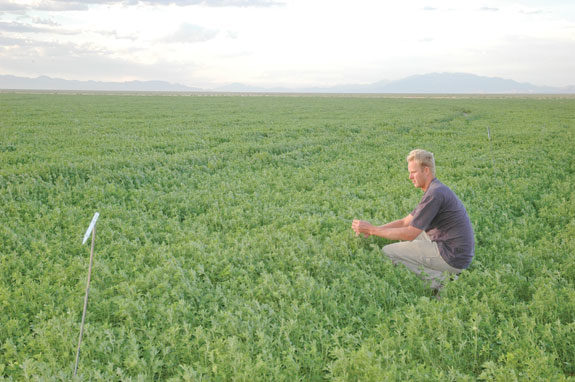For Elar Jenkins of Tonopah, Nevada, it not only made sense, it has become one of the most productive forage businesses in the state. He will be the first one to tell you, however, it hasn’t come without a lot of trials and help from a supportive family.
“Without the help of my mom, dad and brothers, I wouldn’t be able to do what I am. It has taken everyone to get things up and running and it looks like there will be plenty for everyone to do as we continue to grow. It has taken both work and a lot of careful planning and patience to bring everything together.”
While quality hay production isn’t new to the high desert plains of the Intermountain West, taking over an area like Elar and his family did might be considered more risk than most people are willing to go out on a limb for.
The research that went into the land selection was just the beginning of what has become one learning experience after another.
“It took awhile to decide on the land we did. After a lot of research and studying several soil and water surveys, we chose this land because it sits on top of one of the biggest underground water reservoirs anywhere.
We wanted to make sure we would be able to irrigate all the acres we wanted to without concern of running out of water. Farming in the desert isn’t going to go very far if you constantly have to worry about keeping the ground wet when it is needed.
We don’t want to use any more water than is necessary for alfalfa production, but we didn’t want to be investing in a bad area either.”
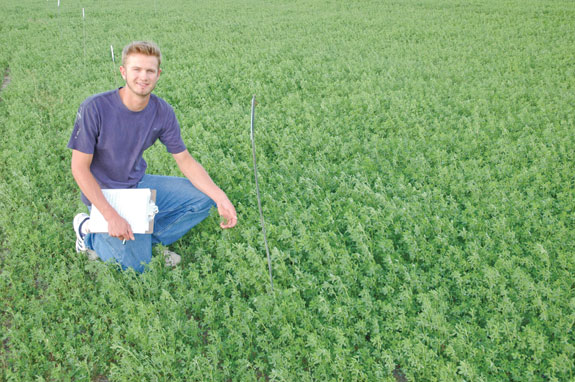
Water wasn’t the only concern for the Jenkins. With the desert also came another set of challenges with the soil that the alfalfa would be going into.
Although alfalfa is tolerant of and in many cases prefers the soil to be slightly alkaline, the soils of Nevada push the growth and establishment of plants to the extreme limits of adaptation. Elar joked about the daunting situation of overcoming the limits of the soil in a way that only someone from the area would fully appreciate.
“In a lot of ways, it’s like getting plants to grow in baking soda. We have some of the highest-pH soils anywhere in the U.S. and they are white enough to make a pretty close comparison.
It might be tolerable if it was just the pH we had to contend with, but the only native plants that grow in this stuff will rip the treads right off the tractors we use to clear the land with. We can only clear the brush off in one direction if we want to have something running at the end of the day.”
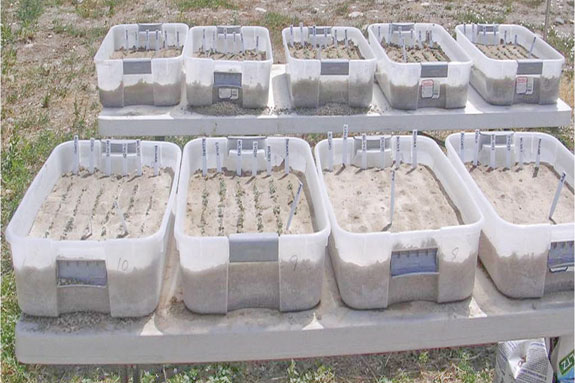
As with the soil and water situation, the varieties of alfalfa under consideration for planting went through a series of trials and tests before the best ones were selected.
Elar’s father, Scott Jenkins, headed up the variety experiments for their rapidly expanding plans and farm.
Elar pointed out that it takes a rather large learning curve when you are dealing with an area that few have grown successfully in before.
“Before we planted anything, it had to go through a germination and growing test we set up. My father is the real researcher in the family, so while my brothers and I were getting the farm ready, he spent a lot of time germinating and testing different varieties in the soil they would have to make a home in.
We got a lot of advice and promises from several seed representatives, but testing it the way we did gave us the feedback we needed to make the right decision about what eventually was planted.
No one has really tested their seeds in our soil, so it was important for us to find out for ourselves exactly what we could expect when we planted.”
While not everyone would go through the experiments and testing as the Jenkins did before they put many of their current ideas and varieties into use, the need to find the best way to keep plants healthy and productive in such adverse conditions became one of the biggest projects of the entire enterprise. Once the plants were up and growing, Elar discussed what it took to get them to their prime.
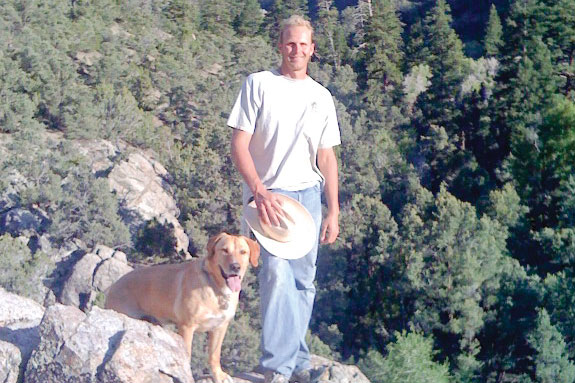
“We received a lot of advice from neighbors and fertilizer dealers throughout the area. It seems there are a lot of ideas as to how best deal with the growing alfalfa, but few long-term projects to fall back on. We finally decided we would do our own testing right in the middle of the field.
For each product we were trying we decided to mark off an area 10 by 10 feet and give each one an equal chance at success.
“After just a few weeks, we were quite surprised to find that the basic, conventional fertilizer blends were outperforming most of the latest and greatest ideas in growing plants.
Our neighbors (if you can call someone 50 miles away a neighbor) had also tried some different soil enhancers and fertilizer blends, but over time weren’t convinced they were a great addition to their farms.
It didn’t take too long for us to come to the same conclusion that sometimes the old standards in fertilizing and soil conditioning are still at the top of the game. I wouldn’t have guessed that with everything we heard, but for us, it was true.”
In all, 13 different products were tested in their fields to determine what direction to take fertilization and soil conditioning to get the desired results.
Although the beginnings of what is now Ayala Farms took a lot more time and experimentation than most farms do, the future is shaping up to be bigger and better each season. As Elar puts it, what was the end of their initial testing has only set them up for a future of haying success.
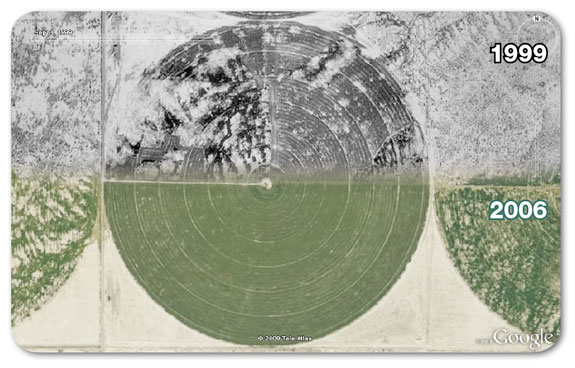
“Over the next few years, we plan on having just over 20 pivots growing alfalfa and other forage crops for buyers in California and other southwestern states.
We cave come a long ways in just a few years, but we have a long ways to go to get where we would all like to be.
Being in the hay industry is great for me personally because it gives me a perfect blend of working hard during the summers and enjoying skiing and other winter sports during the winter.
I couldn’t ever see myself behind a desk or doing something that kept me from my family or things I love.
With their help, I am finding something that works for me and hopefully will be a success for all my family that wants to make Ayala Farms their home.” FG
PHOTOS
PHOTO 1: Elar Jenkins takes the latest measurements in the field trials set up to determine which fertilizers work best in the high alkaline soils of southern Nevada.
PHOTO 2: Austin Jenkins revisits the test plots at Ayala Farms.
PHOTO 3: Germination tests using soil from Ayala Farms.
PHOTO 4: Elar Jenkins takes time to enjoy his favorite outdoor locations during some down time. Photos courtesy of Scott Jenkins.
PHOTO 5: Pivot ground purchased by the Jenkins shows the change in productivity after they incorporated their best growing practices. Photo courtesy of Google Earth.
Darren Olsen
Progressive Forage Grower Editor
